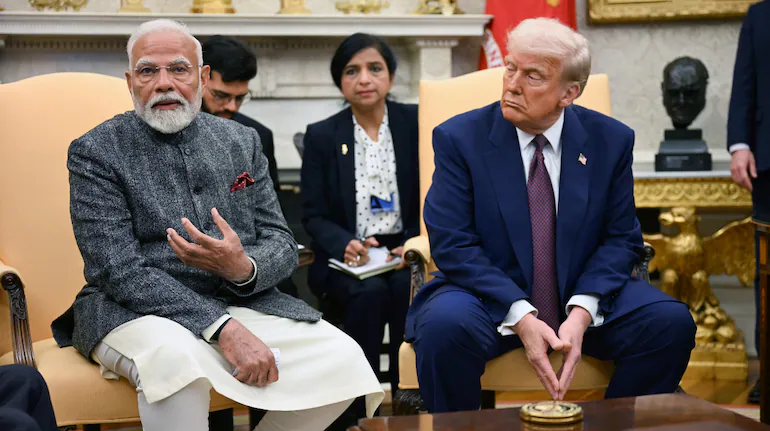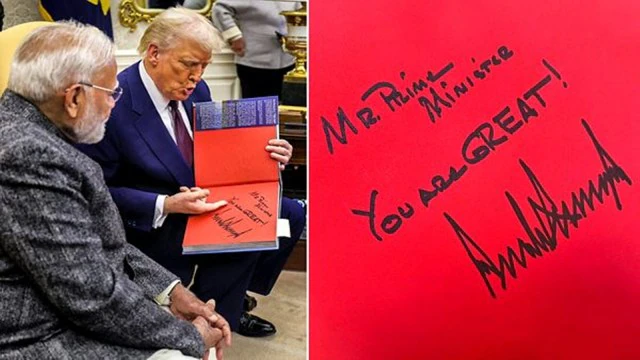 Introduction: The Grand Spectacle of Friendship and Trade
Introduction: The Grand Spectacle of Friendship and Trade
Ah, India and America! The world’s most dramatic diplomatic duo, where grand handshakes 



Trump called Modi his “good friend,” but history has taught us that in politics, friendships last only as long as they serve national interests. So, let’s embark on a satirical journey 🎢 through the maze of India-U.S. trade relations, their so-called friendship, and the looming AI-driven future. 🤖

 Friendship or Just a Political Performance?
Friendship or Just a Political Performance?
From ‘Howdy, Modi!’ in Houston to ‘Namaste Trump’ in Ahmedabad, the world has witnessed grand spectacles of their political romance. 💕 But was it ever real? Or was it just another political performance designed to woo domestic audiences while backdoor trade negotiations remained as ruthless as ever?
While the optics of their friendship looked promising, the reality was that Trump repeatedly slammed India over tariffs 💰, called it a “tariff king,” and made it clear that America wasn’t in the business of charity. Modi, in response, smiled 😃, nodded, and continued playing the long game of strategic patience. ⏳
 AI Collaboration: A Real Partnership or Another American Dream?
AI Collaboration: A Real Partnership or Another American Dream?
With artificial intelligence shaping the future, both India and the U.S. have talked about deeper collaboration. But let’s be honest—who stands to gain more? While India provides the brainpower 🧠 (think thousands of engineers in Silicon Valley and Bengaluru), the intellectual property, patents, and billion-dollar profits remain firmly in American hands. 💸
Silicon Valley giants, backed by American policymakers, are happy to use Indian talent but aren’t as generous when it comes to technology transfers. So, while AI might be the next big thing in Indo-U.S. relations, the real question remains: Will India be a leader 🏆 or just another outsourcing hub 🏢 for U.S. tech dominance?
 Trade War: Is India the Next Target?
Trade War: Is India the Next Target?
Trump had already locked horns with China 
Instead, America wanted India to open its markets further, buy more American goods 🛒, and reduce its trade surplus. The irony? India’s so-called “balanced” trade deal with the U.S. often looks more like a one-sided shopping list written in Washington. ✍️
 The Great Tariff Tug-of-War
The Great Tariff Tug-of-War
Trump’s administration took offense at India’s high tariffs on American products, particularly Harley-Davidson motorcycles 
India retaliated by imposing tariffs on American almonds and apples 🍏. The result? More angry tweets from Trump 🐦 and a trade war that benefited no one except headline writers and political commentators. 📰
 Defense Deals: A Relationship Built on Billion-Dollar Purchases
Defense Deals: A Relationship Built on Billion-Dollar Purchases
If there’s one area where Indo-U.S. relations flourish, it’s defense. India buys billions worth of American military hardware 
Yes, India gets access to advanced technology, but never the best of the best. While America sells fighter jets ✈️, it ensures India never gets the same cutting-edge tech that its allies do. So, while India proudly parades its U.S.-made weapons, it does so knowing full well that strategic autonomy is still a distant dream. 😞
 Pharmaceuticals: India’s Rare Moment of Upper Hand
Pharmaceuticals: India’s Rare Moment of Upper Hand
During the COVID-19 pandemic, India briefly held leverage when America needed hydroxychloroquine 
For once, the power dynamic shifted, and India had something America desperately needed. But let’s not forget—once the crisis ended, America quickly resumed its habit of imposing restrictions on Indian pharma exports. The romance was short-lived. ❤️🔥
 Dairy Disputes: America’s Dairy Dreams vs. India’s Sacred Cows
Dairy Disputes: America’s Dairy Dreams vs. India’s Sacred Cows
The U.S. wants to flood Indian markets with its dairy products 

India, the world’s largest producer of milk, sees little incentive in opening up its markets to foreign dairy giants. So, while this issue keeps surfacing in trade talks, don’t expect any breakthrough soon. 🔄
 The Future of India-U.S. Trade: More Tweets, More Tariffs, More Drama
The Future of India-U.S. Trade: More Tweets, More Tariffs, More Drama
So, where do we go from here? With Trump gone and Biden in office, things have mellowed, but the fundamental trade disputes remain. The U.S. still wants greater access to Indian markets, and India still wants fairer trade terms.
Will AI change the power dynamics? Possibly. 🔮 Will India finally secure a trade deal that doesn’t feel like a dictated contract? Unlikely. ❌ Will there be more political theatrics disguised as diplomacy? Absolutely. 🎬
 Conclusion: A Friendship of Convenience, Not Conviction
Conclusion: A Friendship of Convenience, Not Conviction
At the end of the day, the Indo-U.S. trade relationship is a marriage of convenience. 
So, as India and America continue their high-stakes trade tango 🎵, one thing is certain—this drama isn’t ending anytime soon. Whether it’s AI collaboration 🤖, trade disputes 💰, or defense deals 🚀, expect more Twitter meltdowns 🐦, political flip-flops 🤹, and carefully crafted handshakes. Because in global politics, friendship is always secondary to national interest. 🌍


















